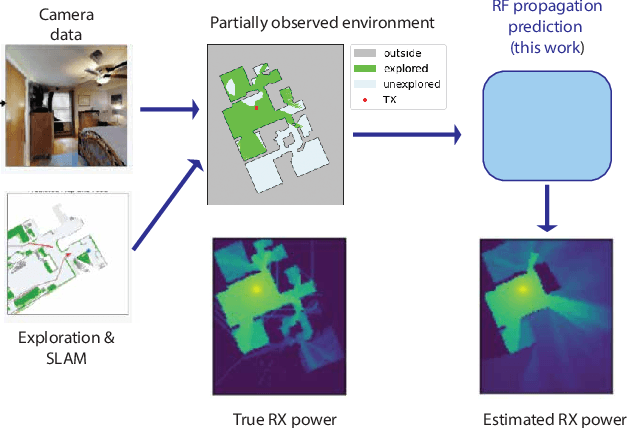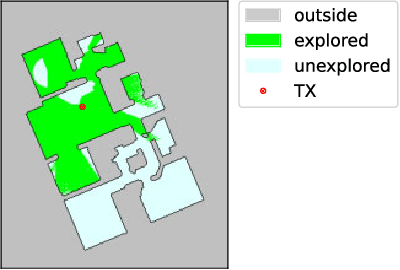Tommy Azzino
JUMP: Joint communication and sensing with Unsynchronized transceivers Made Practical
Apr 16, 2023Abstract:Wideband millimeter-wave communication systems can be extended to provide radar-like sensing capabilities on top of data communication, in a cost-effective manner. However, the development of joint communication and sensing technology is hindered by practical challenges, such as occlusions to the line-of-sight path and clock asynchrony between devices. The latter introduces time-varying timing and frequency offsets that prevent the estimation of sensing parameters and, in turn, the use of standard signal processing solutions. Existing approaches cannot be applied to commonly used phased-array receivers, as they build on stringent assumptions about the multipath environment, and are computationally complex. We present JUMP, the first system enabling practical bistatic and asynchronous joint communication and sensing, while achieving accurate target tracking and micro-Doppler extraction in realistic conditions. Our system compensates for the timing offset by exploiting the channel correlation across subsequent packets. Further, it tracks multipath reflections and eliminates frequency offsets by observing the phase of a dynamically-selected static reference path. JUMP has been implemented on a 60 GHz experimental platform, performing extensive evaluations of human motion sensing, including non-line-of-sight scenarios. In our results, JUMP attains comparable tracking performance to a full-duplex monostatic system and similar micro-Doppler quality with respect to a phase-locked bistatic receiver.
Wireless Channel Prediction in Partially Observed Environments
Jul 03, 2022



Abstract:Site-specific radio frequency (RF) propagation prediction increasingly relies on models built from visual data such as cameras and LIDAR sensors. When operating in dynamic settings, the environment may only be partially observed. This paper introduces a method to extract statistical channel models, given partial observations of the surrounding environment. We propose a simple heuristic algorithm that performs ray tracing on the partial environment and then uses machine-learning trained predictors to estimate the channel and its uncertainty from features extracted from the partial ray tracing results. It is shown that the proposed method can interpolate between fully statistical models when no partial information is available and fully deterministic models when the environment is completely observed. The method can also capture the degree of uncertainty of the propagation predictions depending on the amount of region that has been explored. The methodology is demonstrated in a robotic navigation application simulated on a set of indoor maps with detailed models constructed using state-of-the-art navigation, simultaneous localization and mapping (SLAM), and computer vision methods.
Network-Aware 5G Edge Computing for Object Detection: Augmenting Wearables to "See'' More, Farther and Faster
Dec 25, 2021



Abstract:Advanced wearable devices are increasingly incorporating high-resolution multi-camera systems. As state-of-the-art neural networks for processing the resulting image data are computationally demanding, there has been growing interest in leveraging fifth generation (5G) wireless connectivity and mobile edge computing for offloading this processing to the cloud. To assess this possibility, this paper presents a detailed simulation and evaluation of 5G wireless offloading for object detection within a powerful, new smart wearable called VIS4ION, for the Blind-and-Visually Impaired (BVI). The current VIS4ION system is an instrumented book-bag with high-resolution cameras, vision processing and haptic and audio feedback. The paper considers uploading the camera data to a mobile edge cloud to perform real-time object detection and transmitting the detection results back to the wearable. To determine the video requirements, the paper evaluates the impact of video bit rate and resolution on object detection accuracy and range. A new street scene dataset with labeled objects relevant to BVI navigation is leveraged for analysis. The vision evaluation is combined with a detailed full-stack wireless network simulation to determine the distribution of throughputs and delays with real navigation paths and ray-tracing from new high-resolution 3D models in an urban environment. For comparison, the wireless simulation considers both a standard 4G-Long Term Evolution (LTE) carrier and high-rate 5G millimeter-wave (mmWave) carrier. The work thus provides a thorough and realistic assessment of edge computing with mmWave connectivity in an application with both high bandwidth and low latency requirements.
 Add to Chrome
Add to Chrome Add to Firefox
Add to Firefox Add to Edge
Add to Edge